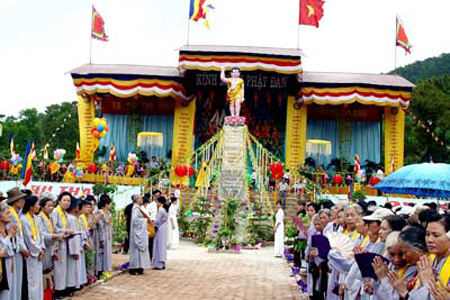The catechism of Hoa Hao Buddhism is reflected in Huynh Phu So's book titled Sam giang thi van toan bo (Complete Works of Literary Oracles). It includes two parts: the Oracular Tenets and the Literary Tenets)...
Prayer Books of Hoa Hao Buddhism
The first part, the Oracular Tenets, is about Huynh Phu So's oracular doctrine of Hoa Hao Buddhism. It consists of six volumes as follows:
Volume 1, the Oracles on Persuading People to Lead a Religious Life, consists of 912 lines of poetry written in 1939 after the establishment of the religion. In this volume, Huynh Phu So gave predictions on the fortune of the country and encouraged people to lead a truly religious life.
Volume 2, a Crazy Man's Prayer, consists of 476 lines of poetry written in Hoa Hao Village in late 1939. In this volume, Huynh Phu So condemned the spreading of superstitious activities and recommended people chant prayers for their salvation.
Volume 3, the Oracles, consists of 612 lines of poetry written in Hoa Hao Village in late 1939. In this volume, Huynh Phu So criticized bad habits such as fascination with trivial material interests and advised people to cultivate their virtue and morality in order to change their karmas.
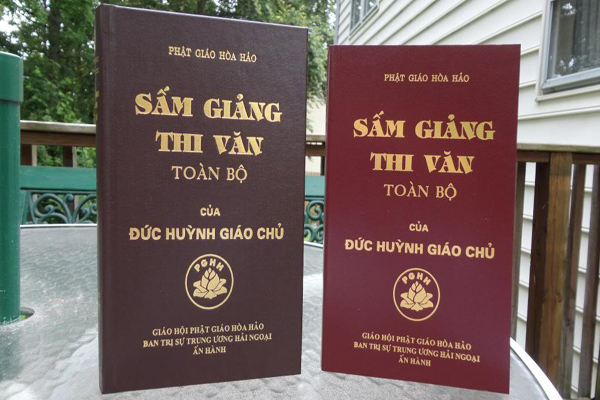
Volume 4, The Dream of Inner Prayers, includes 846 lines of poetry written in Hoa Hao Village in late 1939. This volume presents Huynh Phu So's teachings about Buddhist doctrine, including the Four Noble Truths (Tu dieu de), the Five Aggregates of Human Being (Ngu uan), and the Noble Eightfold Path (Bat chanh dao).
Volume 5, Encouraging Good Actions, consists of 756 lines of poetry written in 1941 in Cho Quan, Sai Gon. In this volume, Huynh Phu So told of Sakyamuni's life and career as a way to encourage people to follow Sakyamuni's example in leading a religious life according to Tinh do.
Volume 6, A Sketch of Knowledge that a Good Buddhist should Know), was written in prose form in Sai Gon in 1945. In this volume, Huynh Phu So gave a further explanation about the Four Debts of Gratitude (Tu an), the Three Karmas (Tam nghiep), the Ten Commandments of Mindfulness (Thap thien), and the Noble Eightfold Path (Bat chanh dao). Rituals of worship and religious practice are also presented in this volume.
The second part, the Literary Tenets, contains 253 poems and prose works arranged in chronological order from 1939 to 1947. This part was named later by the editors in order to distinguish it from the first part. The first part is regarded by Hoa Hao Buddhists as Buddha's revelation to mankind through Huynh Phu So; the second part is regarded as Huynh Phu So's doctrinal interpretation. Actually, the second part includes poems describing landscapes and Huynh Phu So's confidences with doctrinal contents about contemporary society and fortunes. There are even poems about social and political concepts, such as those about the Vietnamese Buddhist Union and the Declaration of the Socialist Democratic Party.
It should be noted Huynh Phu So received some help from poet, friend, and collaborator Pham Xuan Thiep (alias Viet Chau) during his writing. It is also said that poet Nguyen Binh played a part in editing Huynh Phu So's poems when he was traveling southwards. The book, Sam giang thi van toan bo, was first published in 1966 by the Central Department of Doctrinal Dissemination of Hoa Hao Buddhist Sangha.
The Doctrine of Hoa Hao Buddhism
According to Sam giang thi van toan bo, Hoa Hao Buddhism's doctrine consists of two parts: Following Buddha (Hoc Phat) and Self-improvement (Tu nhan). It is suggested that only Following Buddha indicates the dogmas of the religion while Self-improvement showed people how to lead a religious life. This suggestion sounds reasonable. However, both concepts will be presented here for a better understanding of the typical features of Hoa Hao Buddhism's doctrine.
Following Buddha of Hoa Hao Buddhism
Hoa Hao Buddhism believes that this part mainly focuses on the Evil Deeds (Ac phap), the Genuine Deeds (Chan phap), and the Good Deeds (Thien phap). The Evil Deeds are the obstacle for the Good Deeds. The Evil Deeds pollutes people's minds and brings about sins that make humans stuck forever in the circle of life and death. The Evil Deeds are expressed in the theories of the Three Karmas (Tam nghiep), the Seven Feelings (That tinh), the Six Passions (Luc duc), the Five Aggregates of Human Being (Ngu uan), and the Four Social Evils (Tu do tuong).
The Three Karmas include physical, verbal, and mental karmas, which create ten evils. Among these evils, killing living creatures, stealing, and lasciviousness are caused by the body; falsehood, double tongue, vicious tongue, and magniloquence are caused by the mouth; and greed, hatred, and delusion are caused by the mind.
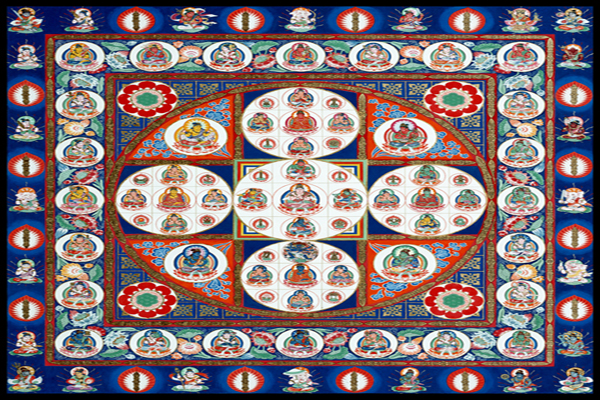
The Seven Feelings refer to the seven states of emotion including sadness, love, dislike, joy, anger, pleasure, and lust.
The Six Passions refer to the six desired things including glory, gain, talent, beauty, unreality, and habit.
The Five Aggregates of Human Being include cupidity, hatred, ignorance, remorse, and selfishness, which prevent humans from salvation.
The Four Social Evils include gambling, booze, promiscuous behavior, and fame. They lead humans to obscurity and evil deeds.
The Genuine Deeds break the obscurity and delusion to reach enlightenment through intelligential brightness. They are expressed in the theories of the Four Noble Truths (Tu dieu de), the Twelve Nidanas (Thap nhi nhan duyen), and the Five Things Polluting Human Hearts and Minds (Ngu truoc).
Huynh Phu So acknowledged the Four Noble Truths of Buddhism, but he rearranged their order and adjusted their content during his teaching as follows: first, Tap de' is the beginning of religious life; second, Diet de is the elimination of evil deeds; third, Kho de is the patient suffering in religious life; and last, Dao de is the attainment of enlightenment.
The Twelve Nidanas refer to the twelve interlacing affinities that result in the cause-effect chain of suffering which mankind cannot escape.
The Five Things Polluting Human Hearts and Minds make humans sink deeply into a miserable and dusty world. If humans recognize the origin of suffering, the cause of the life-and-death circle, and the fact that the dusty world and human life are flawed, then there will be no egotism or passion. As a result, a way of religious life for salvation will soon be found.
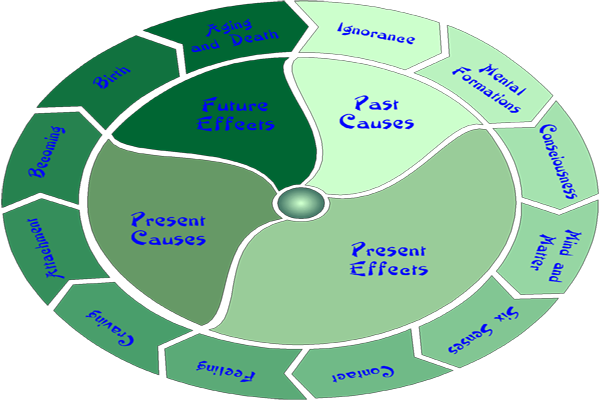
The Good Deeds refer to good deeds that humans should do to create good predestined affinities and purify their hearts and minds so as to reach Buddhist divine positions. The Good Deeds are expressed in the theories of the Noble Eightfold Path (Bat chinh dao) and the Eight Patient Things (Bat nhan).
The Noble Eightfold Path is the path that humans should follow to root out the evil deeds caused by the body, the mouth, and the mind. The eight elements of the path include right view, right action and right livelihood (to eliminate evil deeds caused by the body); right speech (to eliminate evil deeds caused by the mouth); and right mindfulness, right effort, right intention, and right concentration (to eliminate evil deeds caused by the mind).
The Eight Patient Things refer to the eight things which people should be patient in to get over the challenges in their behaviors and religious life, including: treating other people well, strictly following the religious regulations, keeping harmony among neighbors, having respect, and being grateful to your parents, keeping the mind at peace, keeping calm, keeping amiable righteousness and generosity, and being sincere and faithful.
It is noticeable that Hoa Hao Buddhism, as well as Buu Son Ky Huong and Tu An Hieu Nghia, has its doctrine based on Buddhist concepts on the period of Ha Nguyen Mat Phap (decline) and the Long Hoa (a dragon-shaped plant with yellow flowers) Festival to choose Maitreva (future Buddha, who will be reborn to renew the doctrine of the original Buddha). Traditional Buddhism divided its development into three periods. The first period, Proper Dharma (Chinh phap), lasted 500 years after Sakyamuni had passed away. During this time, the dharma was kept fully alive, and the religion had a large number of believers. The second period, Dharma Image (Tuong phap), lasted for the next 1,000 years. At that time, there were fewer people following the religion. The third, Dharma Ending (Mat phap), lasted for the next 1,500 years. It was the decline period of Buddhism, as well as the eradicated Ha Nguyen era of the world. It was then followed by the Thuong Nguyen era when Maitreya appeared and preached in Long Hoa garden, like when Sakyamuni was enlightened at the foot of a Bodhi tree.
In short, the first part of Hoa Hao Buddhist doctrine, Following Buddha, showed the belief that due to the factors such as the three karmas, the six passions, and the five aggregates, humans perpetrate evil things and suffer from the circle of life-and-death. Only by attaining the Genuine Deeds and understanding the theories of the Four Noble Truths and the Twelve Nidanas, can they eliminate the Evil Deeds. At the same time, it is necessary for them to improve themselves through the Noble Eightfold Path and the Eight Patient Things to achieve Good Deeds so as to escape from suffering and become sages.
Therefore, the first part of Hoa Hao Buddhist doctrine was an abridged and edited version of the Buddhist doctrine, which made Hoa Hao Buddhism a sect of Buddhism.
Self-improvement of Hoa Hao Buddhism
This part emphasizes self-improvement following the Four Debts of Gratitude (Tu an), including gratitude to the ancestors and parents, gratitude to the country, gratitude to the fellow countrymen and the mankind, and gratitude to the Three Refuges. Here are the explanations for these four debts of gratitude in Hoa Hao Buddhism:
Gratitude to the ancestors and parents: Every person was born and raised by his parents, and his parents were born by his grandparents and ancestors. Thus, he should be grateful to his parents and ancestors. Humans have the responsibility of repaying their parents and ancestors. In order to do that, they should follow their parents' words, and take good care of them when they are sick or old. In order to repay their ancestors, they must not do anything that may cause damage to the reputation of their family. If the ancestors have made any mistakes and caused their descendants to suffer, the descendants have to try their best to improve themselves in order to wash out the stain. This is the first and most important of the Four Debts of Gratitude.
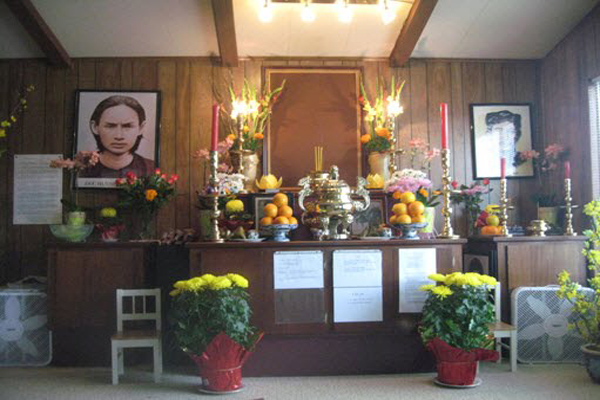
Gratitude to the country: Each person has to be thankful for his country since it is where he and his ancestors are brought up, where he learns traditional habits and customs, and where "his soul is improved and his steps are supported." Each person has to love his country and hometown and contribute to the development of his country depending on his ability. Each person has the responsibility of protecting his country in case of aggression and making sure that he does not betray his country or become a lackey of any foreign country.
Gratitude to the fellow countrymen and mankind: Each person has to treat his fellow countrymen well since they live in the same country, have the same skin color, speak the same language, and are descendants of the Fairy and the Dragon (Vietnamese people). Each person has to be grateful to surround people who have gone through ups and downs with him and assisted him in misfortune. Moreover, each person has to be thankful to his fellow humans regardless of their skin colors, races, and backgrounds according to the spirit of mercifulness, non-ego, and altruism. Each person should not make enemies or cause damages to other people or other nations for his own interests.
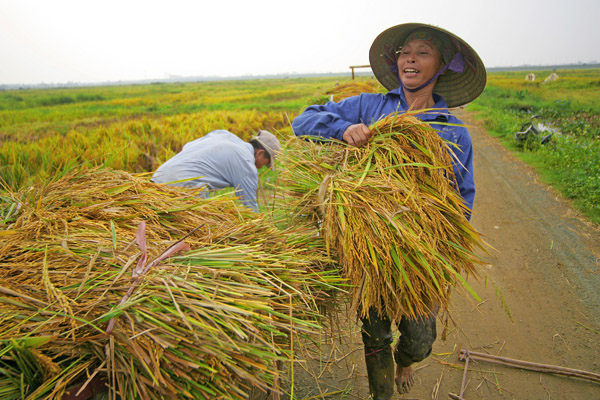
Gratitude to the Three Refuges: The Three Refuges, or Triratna, are the three fundamental objects of worship in Buddhism, namely, Buddha, Dharma, and Sangha. Each person should be grateful to them for their merit in enlightening mankind and saving them from suffering. Each person is under obligation to follow the respectable predecessors' examples for self- improvement, and salvation.
In summary, with the aforementioned theories, Self- improvement is the continuation of the Tay An Buddhist Teacher's and Ngo Loi's thought.
Hoa Hao Buddhism advocates Buddha's learning and self- improvement at the same time. Buddha's learning creates virtue and self-improvement creates merit. Only by achieving both merit and virtue can one quickly becomes a sage. However, Hoa Hao Buddhism pays more attention to self-improvement than Buddha's learning. It is believed that religious life must be based on the cultivation of morality. It is even stressed that one must incessantly cultivate his morality if he wants to become an enlightened one. In other words, without moral cultivation, the Path of Enlightenment is still far away.
With the aforementioned tenets of Following Buddha and Self-improvement, Huynh Phu So believed that Hoa Hao Buddhism was the best sect of Buddhism. It would overcome the drawbacks of Buddhism—the large number of prayer books and sublime and abstract theories which were only suitable for a very small number of followers. Hoa Hao Buddhism was believed to be universal and suitable for the majority of mankind, who could only practice it at home because of the lack of composition and good fortune in the period of decline. Hoa Hao Buddhism's catechism would soon create many good people having merit in time for the coming Long Hoa festival and Thuong Nguyen era. Once becoming members of the Buddhist world, people would be able to enjoy merriness in the Thuong Nguyen era and have the right conditions to continue their self-improvement for the attainment of Buddhist divine positions.
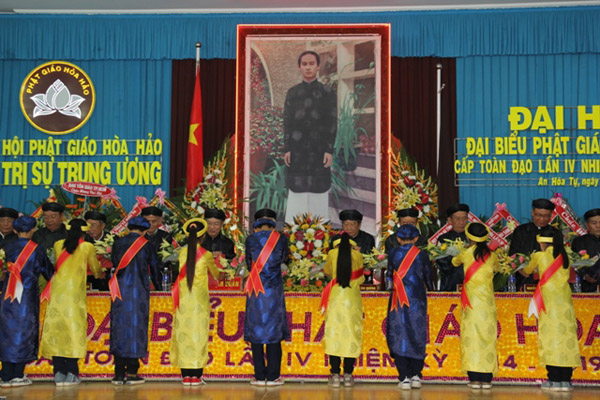
Regulations & Rituals of Hoa Hao Buddhism
Hoa Hao Buddhists mainly practice their religion at home, so the worship and religious practices in this religion are very simple. Only Buddha, ancestors, and national heroes are worshiped. Hoa Hao Buddhists do not worship gods whose origins are unknown.
Hoa Hao Buddhism worships Buddha without statues or pictures, but with tran da (a piece of dark brown cloth), different from tran dieu (a piece of bright red cloth) of Buu Son Ky Huong Buddhism. However, both religions believe that "Buddha is the heart, and the heart is Buddha." Huynh Phu so explained the reason for changing the object of worship as follows: "In former days, we worshiped tran dieu as a vestige of Tay An Buddhist Teacher. Recently, however, there have been many people violating the principles of Buddha, so we have changed the color into dark brown. Moreover, this color has been used by monks up to today to show their refinement. In addition, it is the result of the combination of different colors, so it symbolizes the harmony of mankind, regardless of races and individuals." Formerly, each Hoa Hao Buddhist family had three altars built in their house: the Buddha altar was highest with the tran da only; the ancestral altar was right below the Buddha altar; the altar of Heaven was outside, in front of the door. Later, Huynh Phu So was also worshiped by Hoa Hao Buddhists with his portrait placed below the tran da.
There are only incense, flowers, and freshwater as presents on the altars dedicated to Buddha and Heaven. The cold water represents cleanness; flowers represent purity; incense drives away miasmas. Presents for ancestor-worshiping can be vegetarian food or meat. Huynh Phu So advised Hoa Hao Buddhists against making sumptuous and costly feasts, since the gods and the dead can’t eat them. Particularly, Hoa Hao Buddhists do not use votive paper for the thought that it is unnecessary and wasteful.
Buddhist prayer books are not used in Hoa Hao Buddhism. The followers only read Huynh Phu So's oracles and chanted the Six Words of Amitabha (which means "Glory to Amitabha Buddha") for an undisturbed mind. For this way of religious practice, Hoa Hao Buddhism calls itself "Phap Mon Tinh Do Phat Hoc Tu Nhan" (the Way of Cultivation through Following Buddha and Self-improvement on Pure Earth).
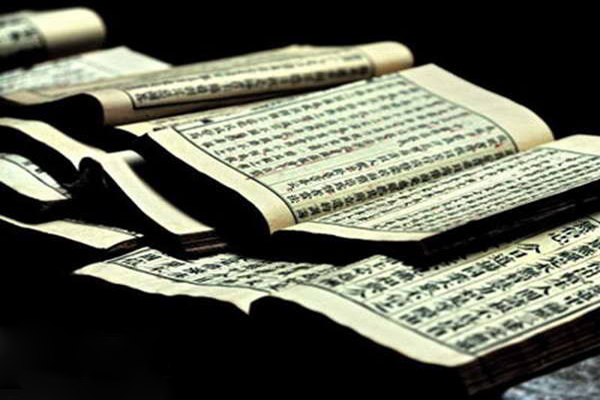
Hoa Hao Buddhists do not kowtow to living people, except their grandparents and parents. Before Healing Buddha of Tay An and Huynh Phu So, they prostrate themselves by turning their palms upward, as these two people are not believed to be dead. Hoa Hao Buddhists have prayers for worship in front of the Buddha altar, the ancestral altar, and the altar of Heaven. Normally, while worshiping, they first hold the incense sticks, shake their joined hands three times, and then kneel down and chant the prayers. After that, they set the incense sticks upright, put their hands together in front of their chest, and continue chanting. They finish their worship by kowtowing four times. When worshiping in front of the altar of Heaven, they shake their joined hands toward the four cardinal points one after another. Hoa Hao Buddhists are exempted from kneeling down if they are weak or away from home. In these cases, they can pray in their mind.
Hoa Hao Buddhists celebrate their festivals according to the lunar calendar. Their main festivals the Nguyen Dan (Lunar New Year) Festival (January 1), the Thuong Nguyen Festival (January 15), the Anniversary of Buddha's Birthday (formerly April 8 and nowadays April 15), the Anniversary of Hoa Hao Buddhism's Inauguration Day (May 18), the Trung Nguyen Festival (July 15), the Birthday Anniversary of Tay An Buddhist Teacher (August 12), the Ha Nguyen Festival (October 15), the Anniversary of Huynh Phu So's Birthday (November 25) and the Anniversary of Buddha's Enlightenment Day (December 8). Of these festivals, the Anniversary of Hoa Hao Buddhism's Inauguration Day and the Anniversary of Huynh Phu So's Birthday are the most important.
Besides, Hoa Hao Buddhists also celebrate other festivals such as the death anniversaries of Huynh Phu So's parents, as well as the birthday anniversaries of the disciples of Tay An Buddhist Teacher such as Nguyen Trung Truc, Tran Van Thanh, and Ngo Loi.
In their daily lives, Hoa Hao Buddhists strictly follow Huynh Phu So's commandments, which are considered the religion's commandments, as follows:
First, followers are not allowed to drink alcohol, gamble, smoke opium, or indulge in debauchery. They have to conform to the Three Moral Bonds and the Five Constant Virtues.
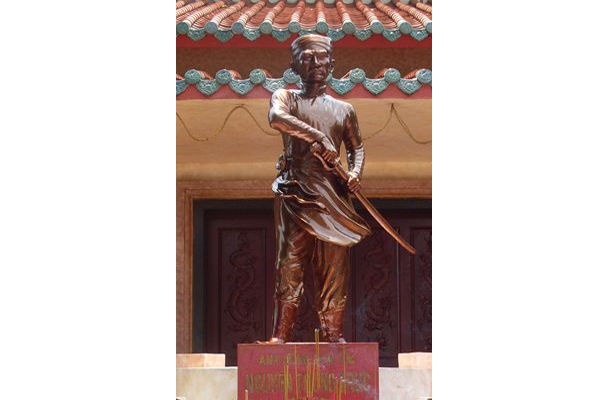
Second, followers are not allowed to be lazy. They have to be industrious and thrifty, give their whole mind to their work, avoid conflicts with others, and willingly forgive others when they are furious.
Third, followers are not allowed to spend excessively on clothes, make corrupt use of money to ignore moral standards, lead a selfish life, fawn upon the rich, or behave badly toward the poor and the miserable.
Fourth, followers are not to entreat God, Buddha, and spirits, or curse them.
Fifth, followers are not allowed to eat beef, buffalo, and dog meat, or kill living creatures and use them as presents to spirits since they will never forgive their sins for their bribes. If any follower commits a sinful action, he/she has to expiate it. Those spirits who receive offerings from ill followers and help them recover from illness are bad ones. If followers keep giving these spirits offerings, these spirits will get used to it and finally disturb them in return.
Sixth, followers are not allowed to spend money on votive paper, since the Ruler of the Underworld never takes it. They should spend that money on helping the miserable and the disabled.
Seventh, followers should carefully consider all issues related to their daily lives and morality before making judgments.
Eighth and last, followers should love each other as children of the same father and help each other in a moral way. Once any follower is enlightened, he/she should return to save and help others.
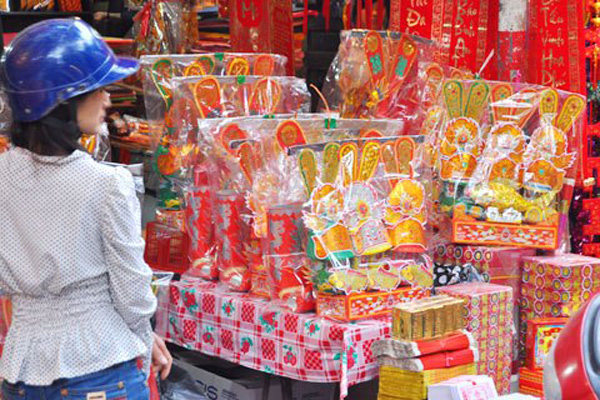
Besides, Hoa Hao Buddhists are also taught to respect followers of other religions. They are taught not to rely on strength in numbers to victimize, speak ill of them, or make enemies of them. They are advised to be in harmony with others, and sympathize and help others, especially in misfortune.
Hoa Hao Buddhists are encouraged to keep a permanent vegetarian diet. Alternatively, they can eat vegetarian food four times a month (on the fourteenth, fifteenth, twenty-ninth, and thirtieth days every month, on the first days of 29-day months, or on important anniversary days of the religion). On the other days, they should abstain from the meat of cows, buffalos, and dogs since they are useful and close to humans.
In Hoa Hao Buddhism, weddings and funerals are carried out simply, economically, and progressively. Parents are advised not to force their children into the marriage, but they have the responsibility to guide and give them advice. Children should not be let free by themselves, since their lack of experience may result in them accidentally ruining their own lives. Hoa Hao Buddhists are also advised not to exact wedding-presents from the future bridegroom's family in the form of offerings or money. Instead, they are advised to celebrate the wedding simply and economically. The wedding and funerals of Hoa Hao Buddhists are similar to those of Vietnamese non-believers. Hoa Hao Buddhists believe that the essential thing for a funeral is sincere prayers for the salvation of the dead. Huynh Phu So also advised people not to cry out loud in the funeral as it can unintentionally prevent the dead from finding salvation.
Hoa Hao Buddhism also refers to many other aspects of social life with a positive attitude like the absolute prohibition of gambling, opium-smoking, and superstition. Hoa Hao Buddhists are advised to learn Vietnamese industriously to broaden their knowledge as well as to support their cultivation. They are also advised to take physical exercises and follow sanitation rules for the belief that only followers who are pure both physically and mentally can attain enlightenment. Hoa Hao Buddhists are not required to keep long hair. However, the majority of male Hoa Hao Buddhists have their long hair twisted in a bun to imitate Huynh Phu So, and to show that they were against the influence of Western civilization. Hoa Hao Buddhists often wear ao ba ba (a kind of loose-fitting blouse used by South Vietnamese people), black or dark brown ao dai (Vietnamese traditional long split tunic). On important ceremonies, they wear white ao dai to represent purity and respect.
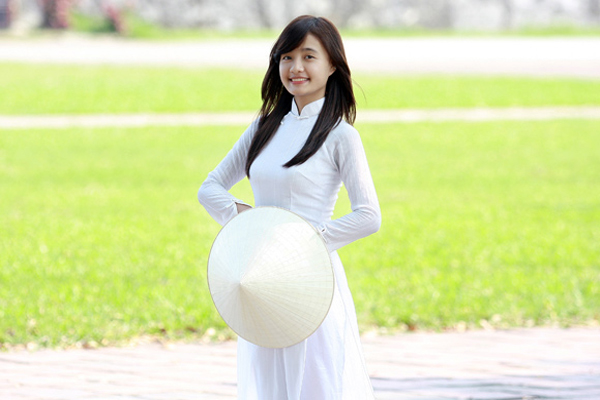
In former days, Hoa Hao Buddhism had considerably strict rules on the ceremonies of joining and leaving the religion, which was partly like those in a political organization. Anyone who wanted to join the religion had to be voluntary and above eighteen years old, submit an application, have recommendations and guarantees from two previous religions, and inform his family about his decision. He would then have to pray in front of his ancestral altar and take an oath to the Three Refuges in "having only one religion in his entire life till death." After joining the religion, he would receive a follower's card, be able to take part in regular religious activities, and be required to pay monthly dues.
Organization of Hoa Hao Buddhism
Traditionally, Buddhism had two forms of cultivation: staying at home and leaving home. Home-leaving Buddhists formed the religious hierarchy. Hoa Hao Buddhism advocates home cultivation, so it has neither home-leaving followers nor a religious hierarchy. In its early stage, the religion was led by Huynh Phu So and his trustworthy disciples. In mid-1945, after unsuccessful efforts in arranging the organization, Huynh Phu So decided to form administrative committees at different levels. However, there existed two other organizational forms along with these administrative committees - Dan Xa Party and the armed force. Furthermore, Hoa Hao Buddhism was playing an increasing role in politics which resulted in the administrative committees being overshadowed. It was not until mid-1945 that the issue of the organizational structure of Hoa Hao Buddhism was taken into consideration. It began with the completion of the Regulations on February 19, 1963, which was later turned into the Charter dated December 6, 1964. However, it was not until nearly a year later that the Hoa Hao Buddhist Sangha was officially recognized by the Sai Gon authority through Executive Order No. 022/65 dated July 12, 1965.
According to the Charter (1965), the organizational structure of Hoa Hao Buddhism is divided into five levels: the central, provincial, district, communal, and hamlet levels. The central level is led by the Central Administrative Council and the Supervisory Council. The Central Administrative Council had 23 members, including one chairman, two vice-chairmen, three consultants, one secretary, and two deputy secretaries. It also includes directors and deputy directors of institutes, including the Supervisory Institute, the Financial Institute, the Religious Institute, the Socio-cultural Institute, and the Organizational Institute. The Supervisory Council has 21 members. Each provincial administrative committee comprises 17 members; each district-level committee, 11 members; each communal committee, 11 members; and each hamlet-level committee, 9 members. The Central Administrative Council lasts three years each tenure; the provincial, district-level and communal administrative executives, two years; and the hamlet-level administrative executive, one year. The total of all-level administrators of Hoa Hao Buddhism came up to 2,000 before the liberation of the South.
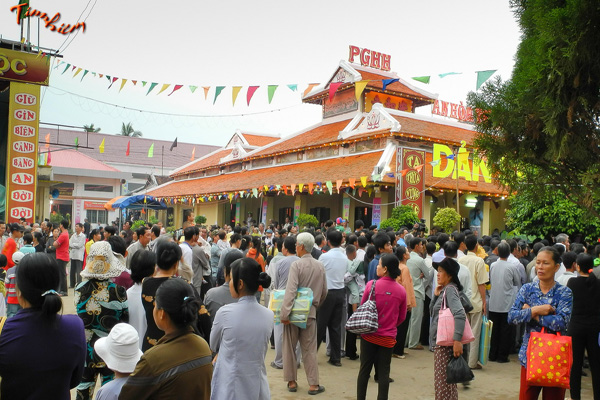
After the liberation of the South, on June 19, 1975, Huynh Thi Kim Bien (Huynh Phu So's younger sister) and Huynh Van Quoc announced the dispersion of Hoa Hao Buddhist administrative committees at all levels due to their political activities, especially those against the revolutionary government. Since Vietnam entered the period of renovation, the Vietnamese Party and Government have enacted religious reform policies, officially recognizing the legal statuses of several religious organizations including that of Hoa Hao Buddhism. On May 26, 1999, the First Hoa Hao Buddhist Congress was held in An Hoa Pagoda, An Giang Province. The Congress passed the Regulations and elected the Board of Hoa Hao Buddhist Representatives, which consisted of 11 members and was headed by Nguyen Van Ton. The Board was the transition to the Hoa Hao Buddhist Sangha. On June 11, 1999, the Head of the Vietnam Government Committee for Religious Affairs issued Decision No. 21/QD- TGCP approving the organization and operation of the Board of Hoa Hao Buddhist Representatives.
After five years of operation (1999-2004), the Second Hoa Hao Buddhist Congress was ceremonially held in An Hoa Pagoda from June 8-9, 2004, and was attended by 571 followers. The Congress approved the Charter regarding the establishment of the Central Administrative Committee of the Hoa Hao Buddhist Sangha. On June 28, 2004, the Head of the Vietnam Government Committee for Religious Affairs, on behalf of the Vietnamese Prime Minister, released written consent for the 2004 Charter and the list of 21 members of the Central Administrative Committee of the Hoa Hao Buddhist Sangha for the tenure 2004-2009. Nguven Van Ton was appointed as the head; Nguyen Tan Dat, Bui Van Duong, Thai Van Nam, and Nguyen Huy Diem, vice-chairmen.
The 2004 Charter specified the operational direction of Hoa Hao Buddhism as follows: "For the Dharma and for the nation, let us carry out the guidelines of Buddha learning, self-improvement, and staying-at-home hermits; let us teach the believers about the Four Debts of Gratitude and the Eight Commandments of our Head, Huynh Phu So, save people in distress, support others on ceremonial occasions and helpfully contribute to society and mankind."
According to the 2004 Charter, the organizational structure of Hoa Hao Buddhist Sangha includes the Central Administrative Committee and communal (precinct-level) administrative committees. Besides, it also has representatives in provinces.
The Central Administrative Committee includes 21 members. It is assisted by specialized departments: the Office, the Financial Department, the Doctrinal Popularization Department, the Organizational and Human Resource Department, the Socio- charity Department, and the Supervisory Department.
The tenure of the Central Administrative Committee lasts five years. The Hoa Hao Buddhist Sangha is headquartered in An Hoa Pagoda, Phu My Commune, Phu Tan District, An Giang Province. Each communal administrative committee consists of 5 to 7 members, including a chairman, a vice-chairman, a secretary, and grassroots administrators in charge of socio- charitable affairs, doctrinal popularization, financial affairs, and supervision. Each communal administrative committee lasts five years.
The central and communal administrative committees are the two official administrative levels of Hoa Hao Buddhist Sangha and have their own legal seals to deal with religious work.
Hoa Hao Buddhist representatives in provinces are recognized as members of the Central Administrative Committee. They are supported by religious-event assistants. They are considered informers of the Central Administrative Committee, as well as the link between it and communal executive committees. The tenure of each provincial representative is the same as that of the Central Administrative Committee.
In conclusion, since Vietnam launched the renovation (1986) with religious reform policies, not only has Hoa Hao Buddhism's religious activities gained more and more respect and security, but organizational issues have been settled more efficiently. The structure of Hoa Hao Buddhism has been reorganized more logically and regained its original religious function.
According to the statistics of the Vietnam Government Committee for Religious Affairs, in 2004, Hoa Hao Buddhism had nearly 1.3 million followers in 18 provinces and cities. The provinces and cities with the largest numbers of followers included An Giang, Dong Thap, Vinh Long, Can Tho City, and Hau Giang.

